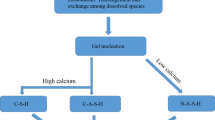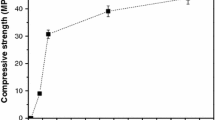Abstract
In contrast to granulated blast-furnace slag (GBFS), many other industrial residues and by-products such as steel slags are currently not utilised to produce hydraulic or alkali-activated binders. Simultaneously, the building materials industry is confronted with steadily growing demands for increased CO2 and resource efficiency, as well as dwindling supplies of traditional supplementary cementitious materials. This contribution covers the characterisation of slag-like compounds prior to and after carbothermal treatment, with respect to their utilisation potential as binder components. The treated materials were highly amorphous with a favourable chemical composition - particularly high contents of CaO, SiO2, Al2O3 and MgO, high (CaO+MgO)/SiO2-ratios (>1.0, ideally > 1.2) and low amounts of unwanted impurities like Fe- and Mn-containing compounds. Subsequent characterisation of the reactivity of the processed materials revealed high hydraulic activity (activity index up to >100% after 28 days) and suitability for alkali-activation. In contrast, the untreated materials showed only insufficient hydraulic activity but could successfully be used as binder components in alkali-activated materials. Chemical indices based on the amorphous content and the content of CaO, MgO, Al2O3, SiO2, FeO and MnO were identified as suitable control parameters for estimating the potential hydraulic activity of slag-like materials.
Access this chapter
Tax calculation will be finalised at checkout
Purchases are for personal use only
Similar content being viewed by others
References
Sobek, W.: non nobis – Bauen in der Zukunft. Band 1: Ausgehen muss man von dem, was ist. AV Edition, Stuttgart (2022)
International Energy Agency: Technology Roadmap Low-Carbon Transition in the Cement Industry (2018)
Environment Agency Austria: Die Bestandsaufnahme der Abfallwirtschaft in Österreich - Statusbericht 2021 (Baseline study of the waste economy in Austria - status report 2021). Austrian Ministry for Climate Protection, Environment, Energy, Mobility, Innovation and Technology, Vienna (2021)
Lothenbach, B., Scrivener, K., Hooton, R.D.: Supplementary cementitious materials. Cem. Concr. Res. 41(12), 1244–1256 (2011)
Habert, G., et al.: Environmental impacts and decarbonization strategies in the cement and concrete industries. Nat. Rev. Earth Environ. 1(11), 559–573 (2020)
Scrivener, K., Martirena, F., Bishnoi, S., Maity, S.: Calcined clay limestone cements (LC3). Cem. Concr. Res. 114, 49–56 (2018)
Ehrenberg, A.: Hüttensand - Ein leistungsfähiger Baustoff mit Tradition und Zukunft. Teil 1. Beton-Informationen 4, 35–63 (2006)
Kurdowski, W.: Cement and Concrete Chemistry. Springer, Dordrecht (2014). https://doi.org/10.1007/978-94-007-7945-7
Ehrenberg, A.: Hüttensand - Ein leistungsfähiger Baustoff mit Tradition und Zukunft. Teil 2. Beton-Informationen 5, 67–95 (2006)
Péra, J., Ambroise, J., Chabannet, M.: Properties of blast-furnace slags containing high amounts of manganese. Cem. Concr. Res. 29(2), 171–177 (1999)
Blotevogel, S., et al.: Effect of TiO2 and 11 minor elements on the reactivity of ground-granulated blast-furnace slag in blended cements. J. Am. Ceram. Soc. 104(1), 128–139 (2021)
Keil, F.: Das Merkblatt für Zementschlacke. Zement 31(19), 208-208A (1942)
Blotevogel, S., et al.: Ability of the R3 test to evaluate differences in early age reactivity of 16 industrial ground granulated blast furnace slags (GGBS). Cem. Concr. Res. 130, 105998 (2020)
Doschek-Held, K., Krammer, A., Steindl, F.R., Eisner, P., Wohlmuth, D.: Thermische Behandlung und Konditionierung von Hüttenreststoffen zur stofflichen Verwertung. In: Pomberger, R. (ed.) Recy&DepoTech 2022, pp. 79–84. Montanuniversität Leoben Lehrstuhl für Abfallverwertungstechnik und Abfallwirtschaft, Leoben (2022)
Li, X., et al.: Reactivity tests for supplementary cementitious materials: RILEM TC 267-TRM phase 1. Mater. Struct. 51(6), 1–14 (2018). https://doi.org/10.1617/s11527-018-1269-x
Mauschitz, G.: Emissionen aus Anlagen der österreichischen Zementindustrie (Emissions by facilities of the Austrian cement industry), Vienna (2021)
Acknowledgements
The research presented herein was conducted as part of the research project “UpcycSlag-Binder” within the program “Green Tech 100 – 1 Earth, 0 Carbon, 0 Waste”, which was financially supported by the “Zukunftsfonds Steiermark” (future fonds Styria) and the “Klimaschutzfonds der Stadt Graz” (climate protection fonds of the city of Graz). The support of Dr. Marcella Ruschi Mendes Saade from Graz University of Technology regarding life-cycle assessment is gratefully acknowledged.
Author information
Authors and Affiliations
Corresponding author
Editor information
Editors and Affiliations
Rights and permissions
Copyright information
© 2023 The Author(s), under exclusive license to Springer Nature Switzerland AG
About this paper
Cite this paper
Steindl, F.R. et al. (2023). Mineral Residues and By-Products Upcycled into Reactive Binder Components for Cementitious Materials. In: Jędrzejewska, A., Kanavaris, F., Azenha, M., Benboudjema, F., Schlicke, D. (eds) International RILEM Conference on Synergising Expertise towards Sustainability and Robustness of Cement-based Materials and Concrete Structures. SynerCrete 2023. RILEM Bookseries, vol 44. Springer, Cham. https://doi.org/10.1007/978-3-031-33187-9_15
Download citation
DOI: https://doi.org/10.1007/978-3-031-33187-9_15
Published:
Publisher Name: Springer, Cham
Print ISBN: 978-3-031-33186-2
Online ISBN: 978-3-031-33187-9
eBook Packages: EngineeringEngineering (R0)




